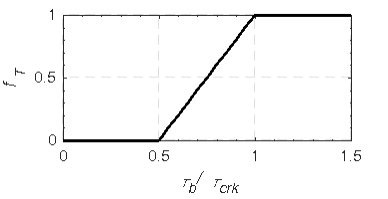Some of the sediment transport potential formulas such as the Engelund-Hansen (1967), Kilinc and Richardson (1973), and others do not include thresholds for transport. This leads to unrealistic transport conditions such as transport of boulders in low flows. In order to avoid this issue, the transport potential formulas are multiplied by a reduction factor when the bed shear stress is below the critical shear stress for transport. The reduction factor is given by
| 1) |
f_T = \max[ \min(2τ_b/τ_{crk}−1,1),0] |
where
τ_{b} = bed shear stress [M/L/T2]
τ_{crk} = critical shear stress [M/L/T2]
A plot of the transport stage correction function is shown in the figure below. The function limits the transport when τb < τcrk, but has no effect for τb > τcrk.

Figure 3 27. Transport stage correction.
The transport stage correction is somewhat ad-hoc but avoids unrealistc transport of sediments at low flow conditions.
In order to avoid unrealistic results such as sediment concentrations which are higher than the bed dry bulk density, the sediment transport potentials are limited. Formulas which only compute the total-load transport potential are limited as
| 2) |
\hat{q}_{tk}^{*}=q_{tk}^{*}\min \left(\frac{C_{t,\max }}{C_{t*}},1\right) |
where
C_{t, max} = maximum total-load sediment concentration [M/L3]
C_{t*}=\frac{1}{Uh}\sum _{k}f_{1k}q_{tk}^{*} = total-load concentration capacity [M/L3]
U = current velocity [L/T]
h = water depth [L]
The maximum total-load concentration may be adjusted by the user but has a default value of 1590 kg/m3.
Similarly, the bed-load transport potential is limited as
| 3) |
\hat{q}_{bk}^{*}=q_{bk}^{*}\min \left(\frac{c_{b,\max }}{c_{b*}},1\right) |
where
{q_{bk}}^{*} = bed-load transport rate potential [M/L/T]
c_{b*} = \sum_k c_{bk*} = bed-load concentration capacity [M/L3]
c_{bk*}=\frac{q_{bk*}}{u_{bk}\delta _{bk}} = fractional bed-load concentration capacity [M/L3]
c_{b,max} = maximum bed-load concentration [M/L3]
u_{bk} = fractional bed-load velocity [L/T]
δ_{bk} = fractional bed-load layer thickness [L]
The bed-load velocity is computed using one of the methods specified by the user. If no method is specified, the current velocity is utilized which represents an upper limit. The fractional bed-load layer thickness is computed using the van Rijn (1984) formula
| 4) |
\frac{\delta _{bk}}{d_{k}}=0.3d_{*}^{0.7}T_{k}^{0.5} |
where
δ_{bk} = maximum saltation height [L]
d_{k} = grain size diameter [L]
d_{*} = non-dimensional grain size [-]
T_{k} = τ′_b/τ_{crk} - ~\tau_1 = transport stage [-]
{τ_{b}}^{′} = bed skin shear stress [M/L/T2]
τ_{crk} = critical shear stress [M/L/T2]
The suspended-load transport potential is limited as
| 5) |
\hat{q}_{sk}^{*}=q_{sk}^{*}\min \left(\frac{C_{s,\max }}{C_{s*}},1\right) |
where
{q_{sk}}^{*} = suspended-load transport rate potential [M/L/T]
C_{s*}=\frac{1}{Uh}\sum _{k}f_{1k}q_{sk}^{*} = suspended-load concentration capacity [M/L3]